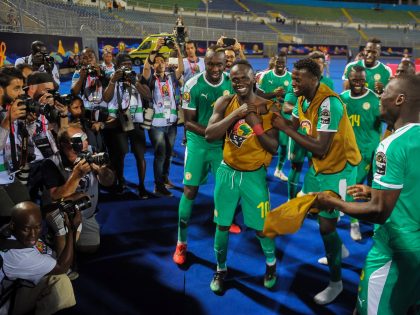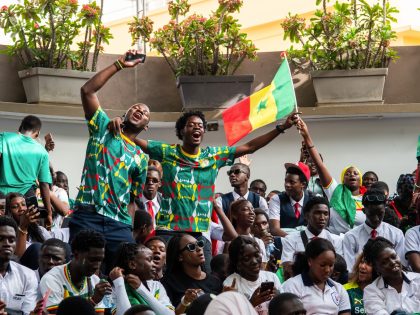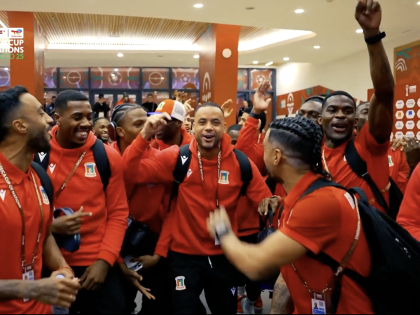Moçambique Popular
Long before football blogging became commonplace and banal, Davy Lane wrote about football politics as a fan. Brilliantly.

Photo: darrenornitz, via Flickr CC.
Davy Lane revived his football blog for the 2010 World Cup which took him to South Africa and then post-World Cup to Mozambique, through his own blog, The Other Football, and later at the blog Football is Coming Home, which I had started along with football historian Peter Alegi. Davy’s dispatches, following the Uruguyan team from Cape Town, Kimberley, Pretoria and Johannesburg, and letting ordinary South Africans talk about their World Cup, are still worth revisiting. Anyway, we asked Davy his impressions of all kinds of media consumption in Mozambique and South Africa. Read it below. The images are by Alyssa Sealock, a student of mine at the New School who had spent time in Mozambique. — Sean Jacobs.
Sean: News reports of the last month–the role of SMS/text messages in organizing bread riots–suggest Mozambicans are avid media users? Can you comment on that?
Davy: Folks in Maputo and Matola (the second a “suburb” of Maputo and scene of some of the more intense street revolts) are indeed avid new media users. The “Revolta Popular” proved as much. Mobiles and multimedia devices are ubiquitous urban accessories, and although SMS and to a lesser extent Facebook, were catalytic, I suspect traditional word of mouth was ultimately more decisive in bringing about the bread riots. The incubator for the insurrection was the Chappas, the local mini bus service. And when Chappas drivers angry at earlier fuel increases choose to strike, suburban passengers were stranded and primed.
It was more difficult to gauge Facebook usage. Internet cafes are not common in the capital,* and although laptops, netbooks and 3G dongles clutter the windows of ‘Mom and Pop and Aunty and Uncle and Niece and Nephew’ Indo-Moçambican appliance stores, I saw few instances of home Internet usage. 3G signals pervade, however, and folks at home clearly have ways to engage social media, more and more I suspect through hand held devices. Trips to shopping malls across the border in Nelspruit for various cargo and the accoutrements of electronic communication are popular reasons to apply for new biometric passports, according to many Moçambicans I interviewed at the Ministério da Migração on Avenida Ho Chi Min. My experience of Moçambican government and business office life was predictable, with screens regularly switching between Facebook and pressing work matters.
Speaking of work, the selling of mobile air-time, seems to be one of the largest employers of young men in Maputo, with canvassers for the (South African) communications duopoly Vodacom and M-Cell interchanging and competing for your Metacais. Suspension of SMS service in the days after the bread riots had an immediate drag on commerce, not to mention the pursuit of happiness. It was clear the ban was counter-productive, and were it to have continued, it could have triggered additional disquiet from other classes, not to mention those whose livelihoods depended on it. Vendors of air-time would have had nothing to throw off, but their fluorescent bibs. Ironically, the ban probably pushed social media devices close to the iconic levels of pão. But the government relented, and were ultimately smug with their show of technical force.
It is also noteworthy how many Maputo residents carry two mobile devices, one for each network. This is not to suggest some sophisticate attachment to technology or show of status, but rather the practicality of being connected.
It is less clear how instrumental new media is in the lives of Moçambicans outside the capital. The riots did not spread, mostly. Local academics and commentators on both State television (M-TV) and Commercial broadcaster (STV) suggested this was because they were less connected. The relatively robust local press reported isolated skirmishes and a handful of arrests in Beira, Nampula and the new boom town, Tete, but otherwise provincial Moçambique was probably less organized, though no less angry.
My experience of provincial Moçambique suggests increasing convergence, however. Long distance Chappas rides up and down the country skirting past Chinese laborers and Cashew merchants and miles from any significant urban centers was a surprisingly connected experience. I regularly exchanged SMS with friends and don’t recall ever seeing less than two bars on my phone. Anyone who has taken the Fung Wah Bus between Boston and New York and lost connectivity in Connecticut will appreciate the comparison. Suffice to say, red and white signal towers trump McBillboards in Moçambique.
As an aside, it is also worth noting that capital is rapidly matching convergence in the provinces. Gas stations and Automated Teller Machines have popped up in random places quicker than guide book editors can return proofs and Chinese tarmac can dry. With Australian and Brazilian coal conglomerates setting up shop in Tete, and the Norwegians striking oil off the coast of Pemba, the first such discovery anywhere along the coast of East Africa, you can expect provincial Moçambique to soon be at the forefront of any future manifestations of social upheaval. But for now, and despite Moçambique being one of the fastest growing economies in Africa (6.9% last time I checked), it remains a predominately rural entity and such talk of social media needs to be placed in the perspective than 80-90% of all Moçambicans do not have regular access to electricity, let alone Foursquare and the rest.
Finally, it should be noted many in Maputo remain aficionados of old school media. An unscientific glance at kiosks or at the cafes and meeting places where folks gather suggest newspapers and periodicals remain popular. I am not fluent in Portuguese, but could understand enough from the local press to know that an increase in the price of pão was coming and was likely to trigger outrage.
Competing with Facebook for the local’s web attention is a rather tawdry site called Afrointroductions.com, where some locals flirt with exotic platinum blonde types like Bruce from Brisbane. Bruce is 33 and wants to meet African women.
Mozambique, like much of Southern Africa, exists in South Africa’s larger shadow. How influential is South African popular culture in Mozambique?
It seems almost everyone you meet in Maputo has a brother or a cousin who works in Joburg, as Johannesburg is commonly known. Weekend shopping expeditions to the malls of Nelspruit are all the rage. South African 4 x 4’s are often sighted spinning their wheels at traffic intersections. There are several daily bus services between Maputo and Johannesburg. 1Time one of South Africa’s low cost airlines recently started daily flights. South African chain restaurants are popular. Everyone knows when Mimmos Pizza is having it’s 2 for 1 night. Cases of Cape Fruit can be found stacked at most corners. And some teenagers in their long stockings and flip flips look to have taken the fashion lead from Johannesburg. So yes, some South Africa seeps in.
But there are other more intense flavors and fruitier influences to be found in Moçambique.
The Portuguese never left. The baking and dining, the language and mannerisms, the fashion and style and the straight up architecture makes Maputo most “continental”. Cape Town is often credited with being a European city in Africa, and this is true to some degree, but it is Maputo where the essence of Europe is strongest. Gents in well-tailored garments exchange Bom Dias with ladies in colorful dresses and heels. If ever the local street urchins were to turn their hands to pickpocketing, then you really would have the quintessentially European city in Africa. But thankfully, you do not. Sidewalk caffeinenation is not an option for many, but pão is fundamental and there is nothing more popular than Portuguese bakeries, though Portuguese banks and broadcasts get their fair share of attention.
Satellite television now brings the old colonial power almost closer than ever, with the exploits of Portuguese football teams having widespread popular appeal. Replica shirts of Benfica, Porto, and Sporting Lisboa are proudly worn by locals, yet few sell or wear jerseys or colors of the great local clubs, such as Ferroviario de Maputo, Liga Muçulmana or Costa do Sol. All this is not to suggest Moçambicans do not possess passionate local affiliations or that they have not been decolonized, but rather to acknowledge the accommodations made and relentlessness of the neo colonialism in a global context.
But global is where it gets interesting for Moçambique because it has a couple of bigger and cooler half brothers. Portuguese colonizers and papal cartographers have ensured Moçambique will always have Brazil and Angola to look up to.
As almost anywhere, billboards promote the usual fizzy drinks and desirable consumer products in Maputo, but those captions have to contend with the brightest and boldest of Brazilian Telenovela stars looking down on them like the wicked saints they are. There may be suggestive Portuguese and Mexican offerings in the afternoon, but come the evening it’s time to get it on Brazilian style. If you want to see what João and Conceição get up on the back of the sofa, then tune in at 8:30 week nights.
Admittedly, there is a particular audience for sauce and steam. It’s not for the kids. So what are their dials tuned to? Ask almost any teen or 20 something what are they listening to or what was just playing, and you will almost invariably be invited to share in some new joint from Angola. I never quite got the translation for “this is dope” in Shangaan or Portuguese, but it always was.
The biggest brother of them all is also here doing his thing. Airports, highways and new football stadiums! It is harder to see how exactly China is influencing popular culture in Moçambique, but the Chinese are an enabling force and the unintended consequences of their contribution will eventually permeate the popular culture in some form or other.
Moçambique’s popular influences are not limited to the neo colonialist or global or big neighbours, however. Mosques and Hindu temples are popular places and there are all kinds of new pop cultures spinning off those institutions.
South African popular culture has serious competition in Moçambique. It does all right. But such is the way things are moving in Moçambique, I would not expect it to be too long before the Moçambique reverse remix manifests itself in some popular form in South Africa.
You have been blogging for a few years now (how long exactly?), but your blogging really took off this summer (well, winter in the southern hemisphere) when you blogged from the World Cup. Can you speak about the challenges of blogging from South Africa? I know you’ve had some interesting, but also unfortunate, experiences.
I have been football blogging since late 2006. I was then somewhat of a pioneer, though I never wanted to capitalize by cluttering the blog with banner ads and other commercial links. My football blogging was more about tuning my voice for other writing projects, particularly a book on the African Diaspora and football (which I hope to have in some order ahead of the 2014 World Cup in Brazil), and sharing football with friends.
Football blogging has since turned into an industry with a lot of bloated commentaries mostly about the Premier League and certain star performers. I try to avoid those, which is why I titled my blog, “the other football”. In the months before the World Cup, I joined “Football is Coming Home” a football blog set up for the duration of the World Cup. The other bloggers were Peter Alegi, author of “African Soccerscapes: How a Continent Changed the World’s Game,” and Sean Jacobs (of AIAC, who also founded that blog). Peter has continued the blog.
My blogging probably took off this summer because I presenting the South African football supporter perspective. It was very vox pop. I was putting a camera in front of people’s faces, people who have probably have had never had a camera in their faces before. The last interview I uploaded was with Moses, a Johannesburg garbage collector, perched on the back of his truck, about who he was feeling after Bafana Bafana were eliminated. The following night my laptop was taken from the flat where I was staying in Bramfontein and with it numerous other interviews exploring the dynamic of which teams South Africans should cheer for in the closing stages of the tournament. It became difficult to blog without a writing device, and I regret not investing in a multi media mobile, which would have permitted me to continue with more snippet like coverage.
My misery was compounded again after the tournament when my video camera was swiped from a café in Stellenbosch. With it went a collection of superb post World Cup interviews with workers taking down the paraphernalia of the tournament, weeks after the world had moved on.
I have since blogged from Moçambique after the World Cup, during the bread riots and the African Nations Cup qualifiers against Libya, but have yet to resume otherwise. My main priority at present is to conclude a chapter I am writing on the Uruguayan contribution to the World Cup in a book titled “The Thrill is Gone: Reflections on the 2010 World Cup in South African and it’s Legacy” to be published by the University of Michigan Press in 2011.
The biggest challenge was to blogging from South Africa was bandwidth.
Did you have a chance to read the South African blogosphere? What do you think of it? Are they important in public debates in that country? What about Mozambique? If not, what are some of the potentials of mobile technology there?
I did not really connect with the South African blogosphere when I was in South Africa. I suspect if I did I would have somehow missed South Africa.
I have in retrospect been wondering what they are saying now and have managed to glance through the offerings and have been rather nonplussed, especially by the assortment of category winners of SA Blog Awards. I suspect when bandwidth improves blogs will improve. That said, I suspect the action is somewhere else, and mobile technology is probably providing a platform for robust debates courtesy of Facebook and Twitter.
South Africa’s print media remains relatively robust, probably a result of South Africa’s limited bandwidth, and what needs to be said in South Africa, gets said in the papers, especially in the country’s Red Tops. The broadsheets seem stuck in a by gone age in terms of format, content and presentation.
Ironically, the most important public debate in South Africa this past Winter was about the control of public and press voices.
As noted above, Moçambicans have already proved they can force their governments to back down through new mobile and social media technologies.
Finally, I know you like music. What sounds do we hear on the streets of Maputo?
You will hear the same MTV global noise coming from Maputo’s bars and restaurants, as you would get anywhere else in the world.
Maputo has a “Guide Book” reputation for being the Rio of Africa, in terms of live music. I am not sure I found that to be the case, though there are several solid live venues, foremost among them, the Gil Vicente, a sort of cross between CBGB’s and SOBs, where Afro Jazz holds sway.
I soon picked up on a saxophone player called Ivan Mazuze, though I suspect he is now more popular with Jazz heads in Cape Town than he is at home.
The most popular performer across the genres and with the widest appeal seems to be “Lizha James”, but hot on her heels would be the ladies, “Neyma” and “Dama do Bling”.
There is a show called Music Box (on the private channel STV) which is broadcast on Friday nights. It’s a good entrée to the scene. It was there I was introduced to a cat who runs by the name of “Slim Nigga”. His stuff is raw and ready. But it was hard to avoid “MC Roger” and “Ziqo”, their ball grabbing, bikini-clad videos were always on the loop. And you can be sure you’ll find all of above from your local street vendor who manage to sell everything except Moçambican club football shirts.



















